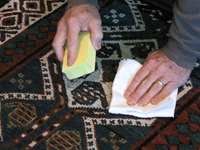Care of Rugs and Textiles
There are four primary threats to the health of Oriental rugs, tapestries and textiles. These are improper cleaning, moisture, light, and insects.
Improper Cleaning
Improper cleaning is a leading cause of damage to Oriental rugs. Talisman advises its clients to wait until they are assured that they have located the right cleaning and restoration service before deciding to clean an Oriental rug, tapestry or textile. It is important to investigate claims, know the difference and obtain reliable references. The danger presented by most commercial companies is due to the harshness of over-the-counter cleaning formulations, hot water, mechanical brushing, washing machines and - in the case of in-home or steam cleaning - inadequate cleaning and incomplete rinsing. The shortcuts of wall-to-wall carpet steam cleaning and traditional commercial cleaning machines are a radical departure from the principles and practices of rug and textile conservation (See our Resources/Links page for in-depth information). It is important to know the experience, methods and reputation of the cleaning service you choose (or, in the case of an Oriental rug dealer, of the rug cleaning service that they have chosen to contract with). The aim of conservation cleaning at Talisman is to preserve the intrinsic qualities of an Oriental rug or textile through an individualized treatment and detailed hand cleaning. Other methods are more superficial - addressing only the appearance of soiling, not the reality of soiling. In the cleaning trade, rug cleaning is often referred to as "appearance management". However, Talisman's individualized approach results in - not only a thoroughly clean rug - but a healthier rug that will maintain its beauty far into the future.
Moisture
Water staining is caused, not by the water itself, but by material dissolved in and transported by it. Wool, silk and cotton react with many substances. These may, in effect, dye the material and resist being removed. Flooding brings tannins, iron and dyeing substances into the rug or textile from floors, roofs, furnishings, etc. When the textile is wet with more than 75% humidity for more than a week, mold fungi can grow and weaken the rug. When it is 100% wet for a week or more, both bacteria and fungi may irreversibly damage a rug or textile. Flower pots, pet dishes and patio doors are the worst causes of rot. If there is a flood, it is possible to have the rug dried in an emergency by a restoration company or carpet cleaner. When dry it will be fairly stable. However, it should only be cleaned professionally by a trusted conservator.
Light
All wavelengths of light contribute energy that accelerate chemical reactions in dyes and textiles. The strongest reactions occur with light near the blue and ultraviolet end of the spectrum. In time, with exposure to light, natural fibers become brittle and break down. Dyes fade. Sunlight provides a large amount of UV light, and windows should be filtered to eliminate it. Items should not be placed in direct sunlight if it can be avoided. Fluorescent lights also radiate UV in great amounts and should be filtered if used. In Indonesia, some textiles have survived for more that 600 years because they have been stored away from light. In Central Asia and South America, textiles that have been kept dry and in total darkness are still relatively robust after 2,000 years. However, in the West textiles and Oriental rugs that have survived more than 175 years are rare. Modern conditions of lighting are one of the worst hazards to natural fibers.
Insects
Webbing and case-bearing moths, black and variegated dermestid beetles are - among the damaging insects - the greatest threat for wool and silk. Silverfish will feed only on cotton, but require a very humid situation. Tapestries and other hanging textiles are particularly vulnerable. They should be inspected on the reverse side regularly and under any linings. Wool-consuming insects establish themselves in areas where they are unlikely to be disturbed - such as under furniture and under parts of a rug that are least walked upon. Good housekeeping and frequent inspections are the best remedy. Frequent vacuuming can eradicate moth infestations in many instances. Do not use moth balls, moth crystals or pesticides. They are hazardous to one's health and dangerous for textile materials. In the event of a serious infestation, contact a conservator for advice and treatment. Beware of "mothproofing" - the most effective chemicals are now banned in California due to health concerns.
Contact Talisman for advice on any aspect of care or cleaning
Useful Guides For Care
- CARE OF RUGS
- CARE OF TEXTILES (1)
- CARE OF TEXTILES (2)
- STAIN REMOVAL GUIDE FOR TEXTILES (includes Oriental rugs, but for a general approach to emergency rug spotting see the sidebar on this page.)
No project is too small for our care



